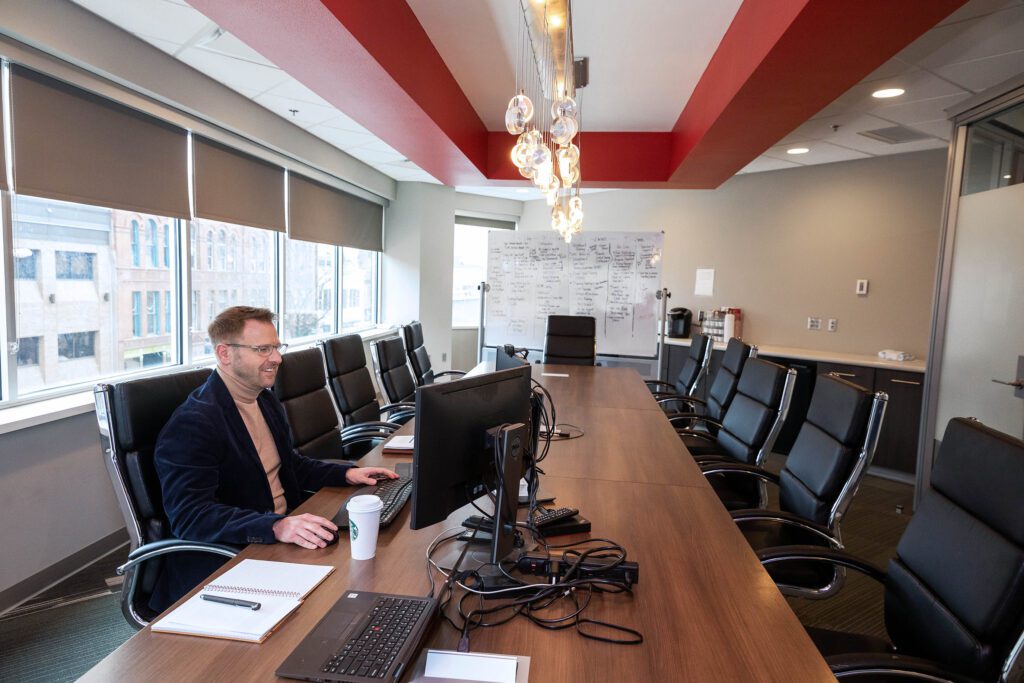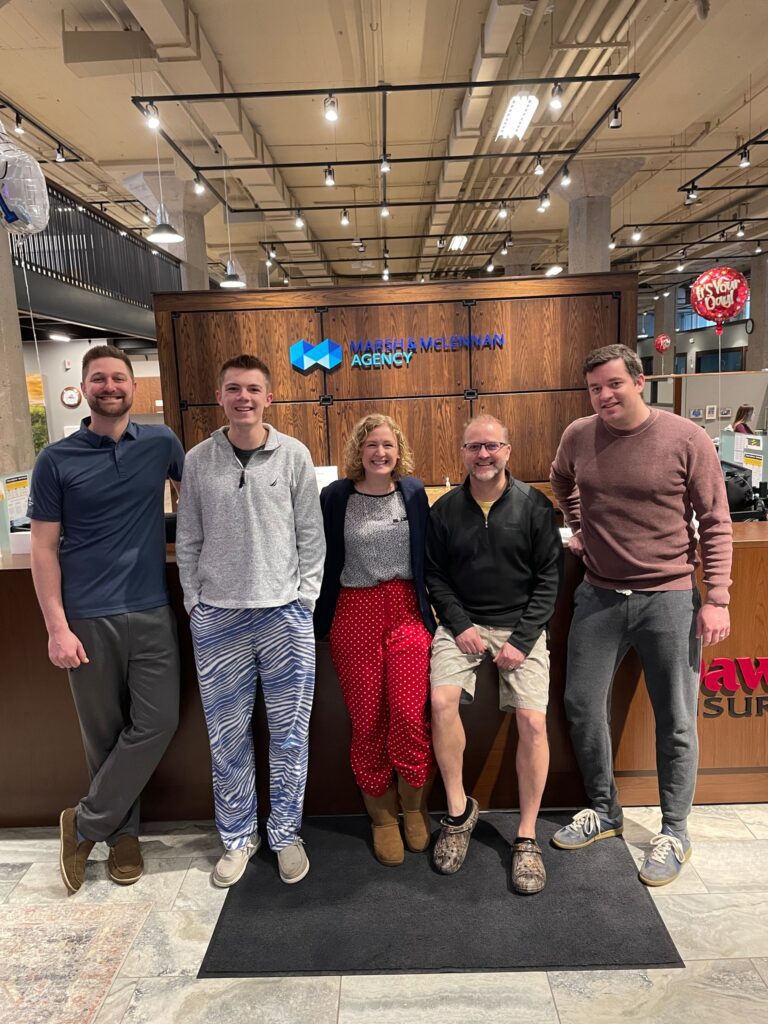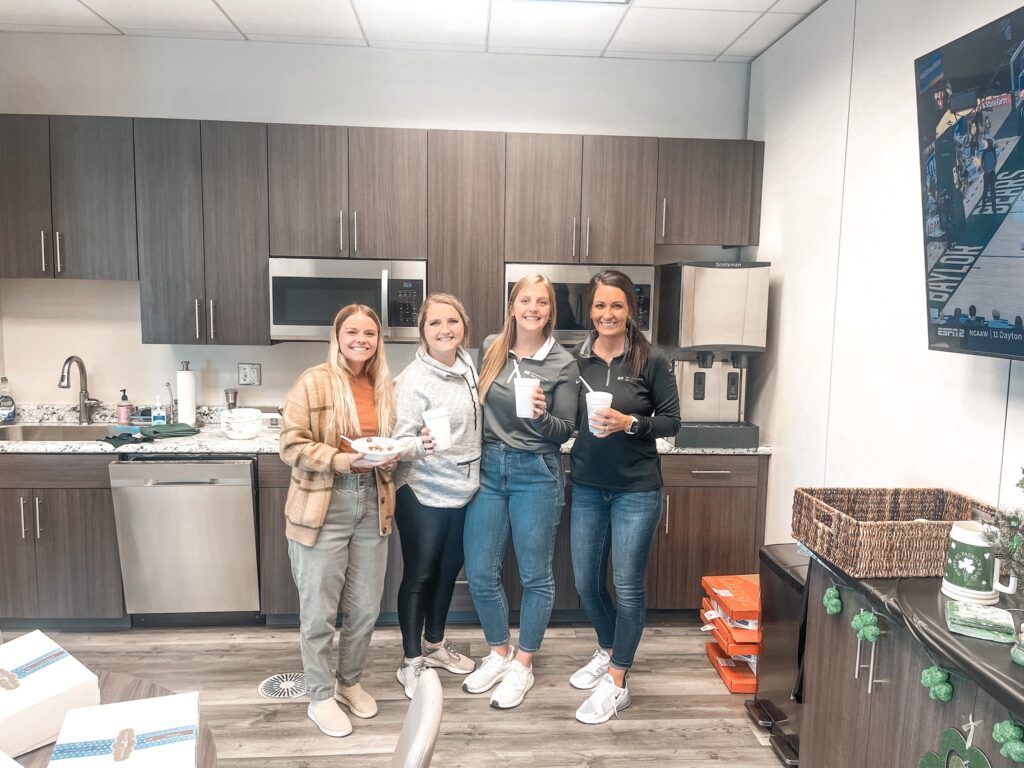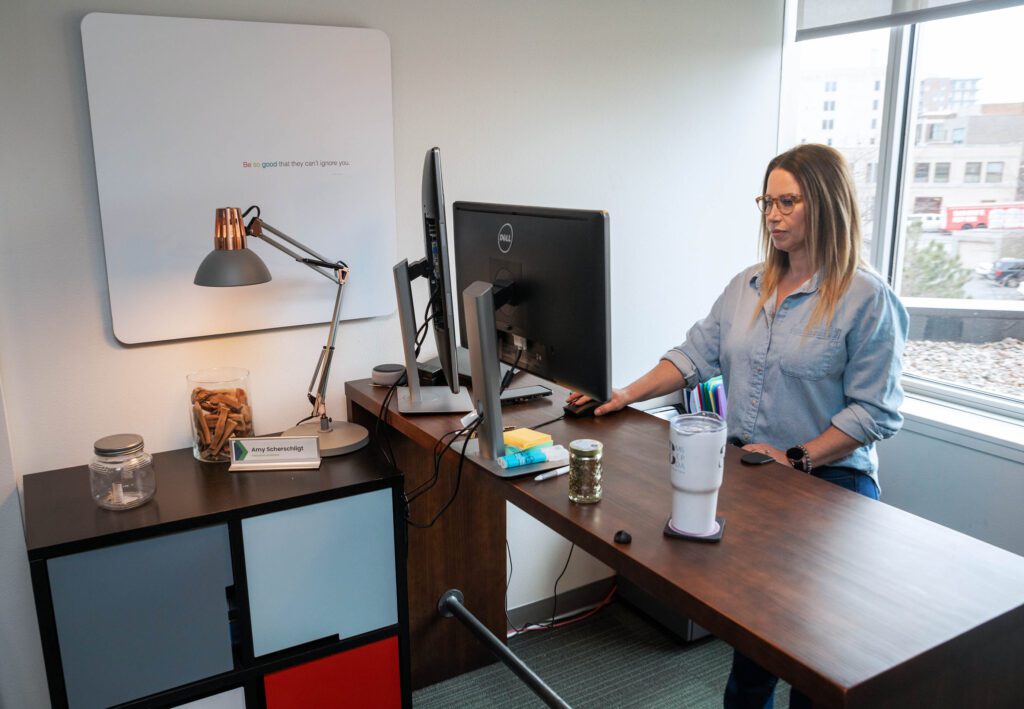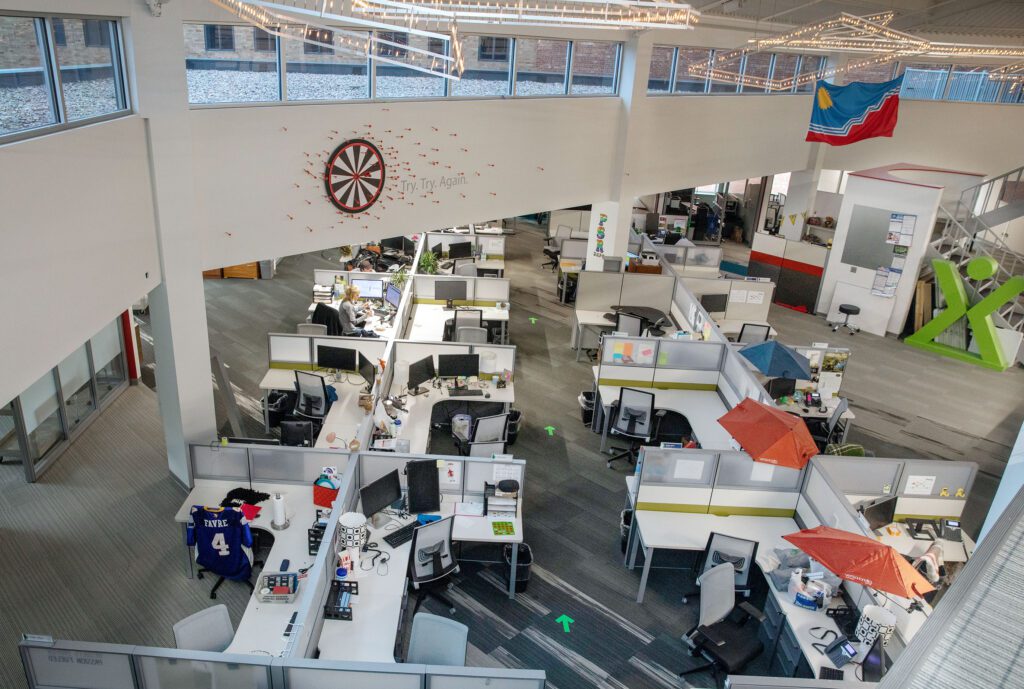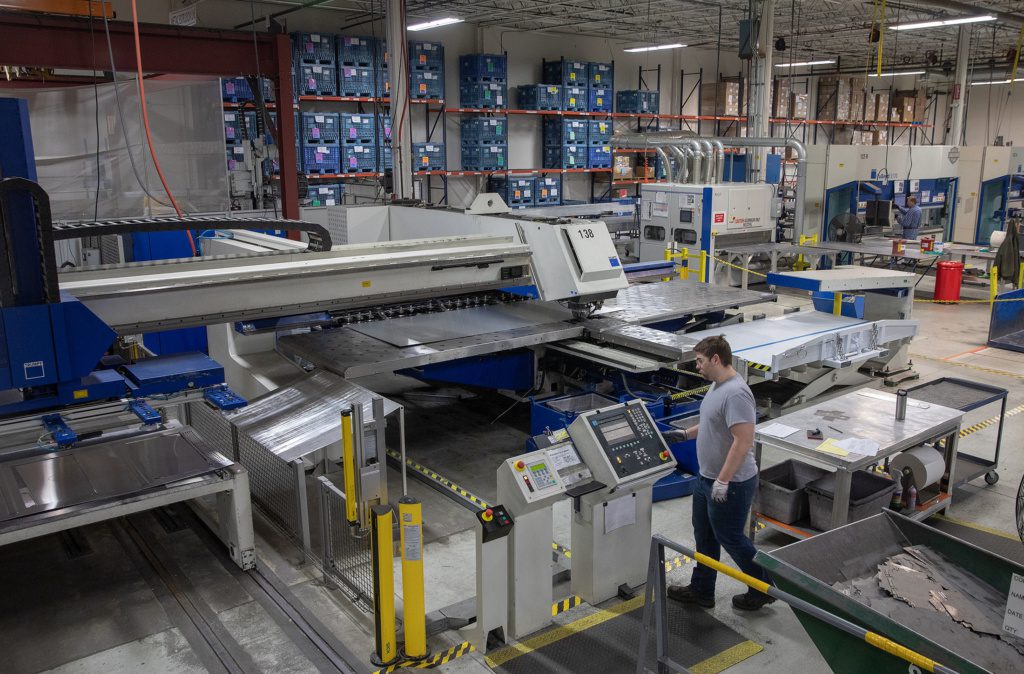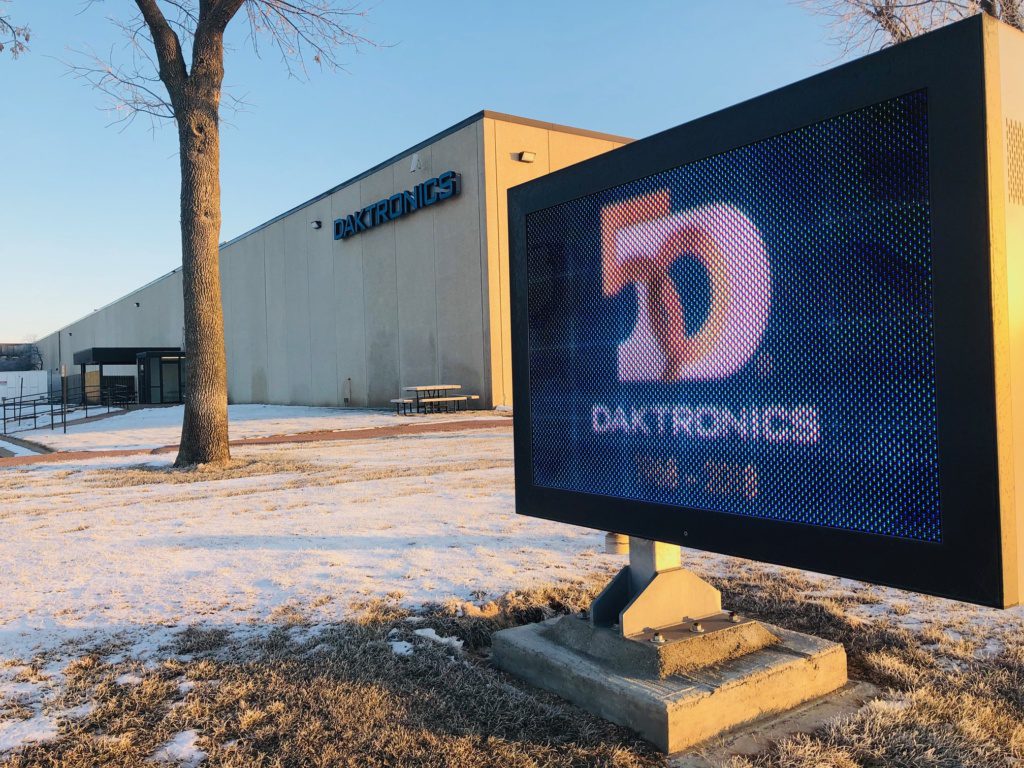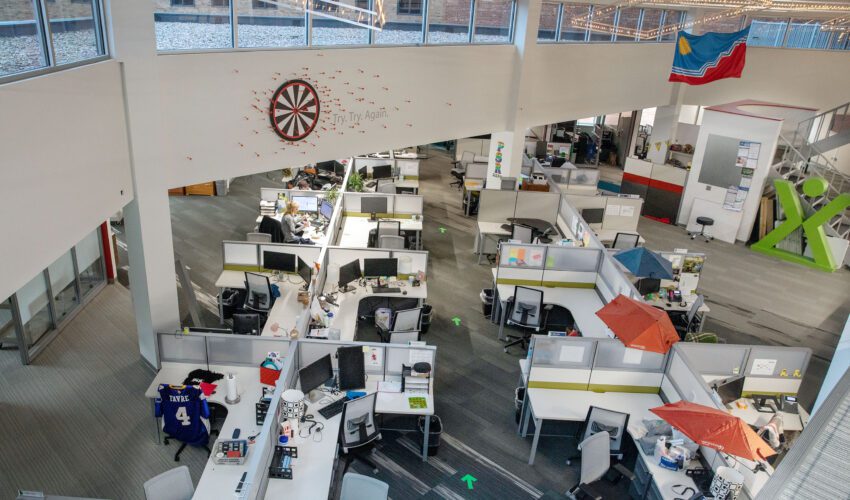Next wave: Businesses returning to office this spring report hybrid, largely remote options
April 18, 2022
When there’s barely anyone in the office, why not make the boardroom conference table your desk?
That’s what Matt Blosl, chief revenue officer of Experity, figured.
And even if he hadn’t been the local leader of the company that used to be DocuTap, it’s not like there was anyone around to suggest otherwise.
“I’ve been coming in every day since day one,” Blosl said of the COVID-19 pandemic shutdown in March 2020. “When this first happened, downtown became like a ghost town. We’ve got four floors, millions of equipment, so it was just odd.”
He now, slowly, counts more company in the downtown office in The Plaza at Ninth Street and Phillips Avenue. But, thanks to a hybrid, flexible arrangement, it’s nowhere close to the estimated 225 Sioux Falls-area employee base.
“It’s definitely been an evolution in terms of balancing what’s smart, what’s safe, what the business demands and what people want,” Blosl said. “I feel like we’ve slowly progressed. We’ve definitely dramatically changed our operating model post-pandemic. We’re much more of a virtual company now.”
Other midsize to large area employers are finding the same – particularly those with corporate headquarters or significantly sized offices out of state.
After months, even years of essentially remote work, they are slowly coming back to the office this spring and attempting to navigate what that looks like.
Easing back
The Sioux Falls office of Marsh McLennan Agency recognized it might be a challenging transition for some employees who hadn’t been coming into work for two years to return.
So in preparation for a hybrid return to the office in March, the team organized a return-to-work event before everyone officially was expected to be back later in the month.
It was a way to “stop by, get your workspace set up, so that way when they came in, it felt like home,” office manager Tracy Wheeler said.
“We tried to create some excitement about coming back with breakfasts and lunches and happy hours, and we made these ‘welcome back to the office’ signs. Some people we hadn’t seen in two years.”
To commemorate the end of working entirely from home, the team came to the office dressed for Zoom calls.
While it was emotional and an adjustment for some figuring out a new routine, “it’s been nice to hear the laughter and all the talking around the office,” said Jamie Baker, human resource director. “And we heard from more than one colleague who said, ‘I didn’t realize how much my mental health needed this.’ They didn’t realize what they were missing.”
The Sioux Falls office is requiring most employees to spend three days per week of their choice in the office, including a Monday or Friday.
“We really involved our culture team to try and promote this, what can we do to make it successful, and I think it’s great,” Wheeler said. “We see people going to lunches, we have a couple new baby announcements and weddings, and everyone just feels connected again.”
At any given time, there are more than 60 people in the office, with Wednesday being the busiest, they said. Each person has a dedicated desk – about 90 all together.
While the office had added some out-of-state workers during the pandemic, especially in specialized roles, the emphasis is on hiring locally. Still, even those who don’t live in the area will come for a whole week, Wheeler said.
“So I feel like we still engage with them, and we try our hardest to make sure remote employees feel included and part of the office.”
National guidelines
The local offices of global financial services companies Citi and Wells Fargo & Co. have been following their national policies, which involved some return to work this spring.
At Wells Fargo, which has more than 2,000 employees in Sioux Falls, most began returning in a flexible, hybrid arrangement in mid-March, though a voluntary return was available earlier based on role and vaccination status. In most cases, employees are required to spend three days in the office.
“We strongly believe in the benefits of seeing our colleagues on a regular basis,” chief operating officer Scott Powell wrote in an all-employee letter.
“It will help each of us foster stronger relationships, support in-the-moment coaching, identify career opportunities and brainstorm new ideas. Ultimately, when we work together, we can better serve our customers and communities.”
At Citi, vaccinated workers at all U.S. locations, including Sioux Falls, started returning March 21. They were asked to be in the office two days per week with the flexibility to work from home up to three days per week.
“Although COVID-19 may never fully go away, we are seeing promising developments,” Citi’s head of human resources Sara Wechter said in a memo reported by Reuters.
Staying largely remote
Other area employers have determined much of their work can and will be done remotely for the foreseeable future.
At Experity, “we’re very flexible,” Blosl said. “We heard from the employee base that post-COVID, while they enjoy their colleagues and love working together, they also enjoy the flexibility that a hybrid model provides, so we’ve acknowledged that, and we’re making accommodations to our office.”
That includes adding “hotel space” for drop-in or occasional workers and more space for groups such as conference rooms. At one point, the company’s office space spanned five floors of the building. That has been consolidated down to less than two floors.
“I think we’re right-sized with the hybrid model,” Blosl said. “On any given day, there could be a lot of people in here, or it could just be me.”
He estimates of a staff of 200, on average about 50 are in the office on any particular day. Sometimes, teams choose to gather to talk through or work on a project. The company provides a budget for travel-related collaboration out of state.
“Our data shows our business is growing just like it was, and now we’re accommodating what people want a little more,” Blosl said.
“In terms of creating a workspace that is attractive to top talent, it absolutely helped. At the point we’re at with Experity, we are competing for talent that can go to Google or Facebook or all these others that have been very flexible … so it’s definitely helped from a hiring perspective.”
At Daktronics, the 2,000-person workforce is a mix of manufacturing workers who must work on-site and a range of other function in sales and service, design and administration.
Those workers are more than half the company and had started evolving to working from home before the pandemic, vice president of human resources Carla Gatzke said.
“I would guess a third of our folks not in manufacturing were working at home pretty consistently all the time, and when the pandemic started, we changed so that everyone who wasn’t in manufacturing would work at home,” she said.
“We had some people who for different reasons … found that working at home didn’t work for them, and we right away accommodated and figured out how to help them be successful on campus just like our folks in manufacturing.”
Now that the workplaces are open more broadly, “we left that to be a choice, and we’re finding that most people, nearly all, prefer to keep working at home,” Gatzke said. “But the campuses are open, the workspace spaces are ready for people. And people do stop in for work when it makes sense for them personally, or occasionally teams will say let’s work on campus today.”
Workers have said “they feel much more productive working at home because they don’t need to commute, pack a lunch or all those activities,” she continued. “And we have found that our leaders are being more intentional about how to build more of a social aspect into our regular activity and how to create and foster events that bring people together in person.”
In some cases, former office space is being repurposed for manufacturing, she added.
And the added flexibility is helping the Brookings-based business attract more out-of-town workers.
“Part of the reason we had more of our team pre-pandemic working at home is because we had more people in Sioux Falls who preferred to live in Sioux Falls and work at Daktronics,” Gatzke said. “We are really seeing our industry come back, and so we are advertising (for workers) on billboards in Sioux Falls.”

